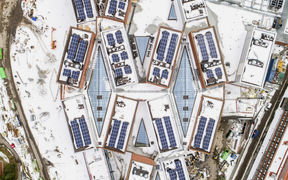Utilising local heat production

The twin pipe district heating system is the most common heating network type used in Finland. In this system, heat is transferred from the heat producer to the network via water and, after cooling down in heat exchangers of consumers, this water is returned to the producer. Currently, all buildings managed by Aalto CRE are connected to the district heating network. As a result, water-based heat transfer methods were investigated in the thesis.
The most common distributed forms of heat production include geothermal heat, solar thermal energy, small-scale heat and CHP plans, as well as various sources of waste heat. Geothermal heat was taken under a closer investigation, as Otaniemi has an excellent geothermal heat potential.
The result of the survey is that a local heating network can improve the applicability of geothermal heat systems in solutions in many buildings.
Calculations
The properties of the heating network were identified using applicable calculations. The use of geothermal heat pumps of 11.3 MW in total were compared in four different cases:
- Each building has a separate geothermal heat system, covering 50% of the peak demand in each building.
- A system as in case 1, except all geothermal heat systems of all buildings are connected to a heating network.
- Only 10 buildings have a separate heat pump, covering the peak demand in each building.
- A system as in case 3, except the system is connected to a heating network.
In case 1, the annual output is 43,300 MWh, or 94% of the total heat consumption of the campus (year 2012). If a heating network is used to transfer geothermal heat (case 2), 44,300 MWh of geothermal heat (96%) can be used with the system.
In cases 3 and 4, a heating network offers significantly larger benefits. If there is no network, 10 building-specific geothermal heat systems can only produce heat for the needs of the specific buildings (25,300 MWh, 55% of the total heat consumption), and the heat needed in other buildings need to be produced using a secondary heat source.
If heat can be supplied to a heating network, heat pumps can produce up to 44,300 MWh, i.e. even 19,000 MWh more than in a building-specific system, covering 96% of the total consumption. Combined with a heating network, a secondary heat source would only need to cover 4% of the total consumption.
Results
On the basis of the calculations, it is apparent that a heating network is highly significant, especially if geothermal heat is only to be built in a specific area and in conjunction with applicable buildings. In this case, the network enables geothermal heat to be used more effectively, without needing any building-specific heat production system. A heating network can even out any production and consumption peaks between different buildings.
A heating network also enables the use of a larger local thermal energy storage that is usually more profitable than a smaller building-specific storage.
The survey also showed that the key property of a heating network considering distributed heat production is the temperature level. The higher the efficiency rate of solar thermal energy and geothermal heat or the availability of industrial heat sources is, the lower the temperature level in the heating network is.
In terms of efficiency, the temperature should be reduced from its current level. However, this is limited by the power transfer capacity of the network at a lower temperature, increased pressure losses as a result of increased flow rates and the minimum temperature of tap water due to the risk of legionella.
Benefiting from the results
The results will be used when designing the energy production system for the Otaniemi area. By investigating local distributed heat production on an extensive level in place of a building-specific level, local synergies in heating and cooling needs can be utilised.
More attention should be paid to the role of the heating network in order to reach the goal of energy self-sufficiency in terms of thermal energy.
It would also be probably possible to use the current district heating network for distributed heat production in Otaniemi. Because the heating network plays a significant part in becoming self-sufficient in terms of thermal energy, it is important that the heating network is developed in cooperation with the current network holder.
Sustainable campus
The key environmental impacts of the campus are related to energy consumption and transport. A sustainable and carbon neutral campus is at the core of the campus strategy.







